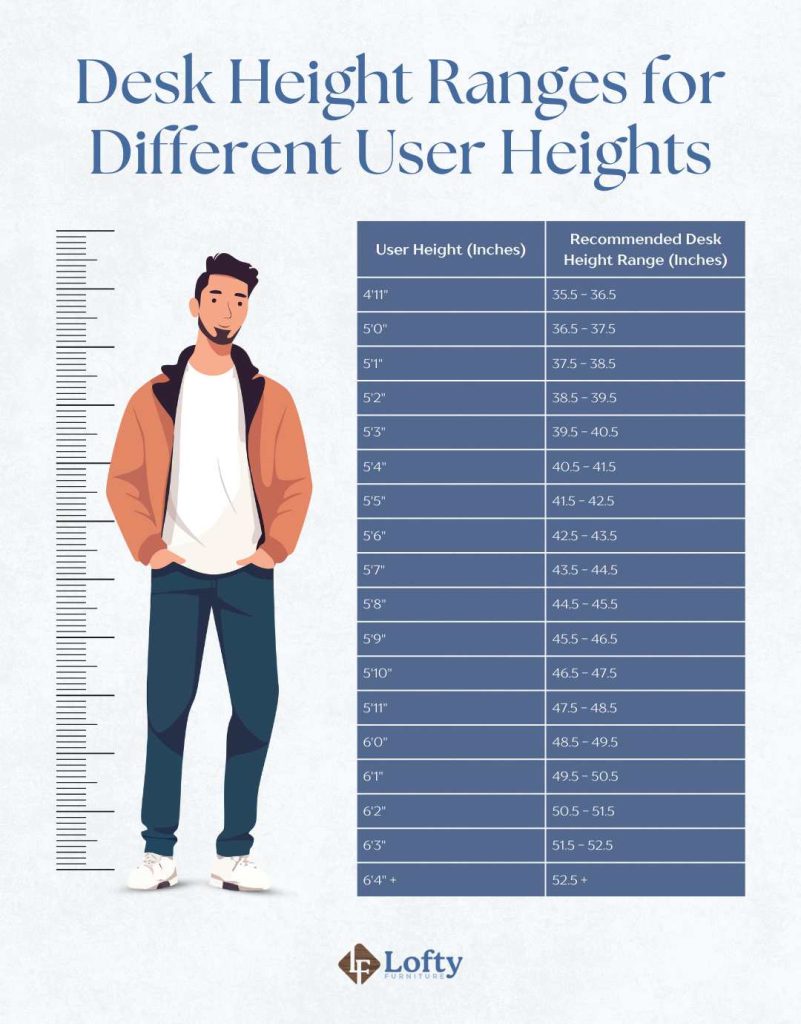Standing desks have gained immense popularity as a way to combat the sedentary lifestyle associated with traditional office work. They offer the flexibility to switch between sitting and standing throughout the day, promoting better posture, blood circulation, and overall well-being. However, simply owning a standing desk isn’t enough. To truly reap the benefits, it’s crucial to set it at the correct height.
Key Takeaways
- Setting your standing desk at the correct height is essential for promoting comfort, good posture, and overall well-being.
- Several factors influence the ideal standing desk height, including your height, footwear, elbow angle, monitor height, and task variety.
- You can calculate your ideal standing desk height by measuring your elbow height and making adjustments for footwear and monitor placement.
This article will guide you through the process of calculating the ideal height for your standing desk, ensuring a comfortable and ergonomic workspace that supports your health and productivity.
Why Standing Desk Height Matters

Ergonomics is the science of designing workspaces and equipment to match the needs of the human body. It focuses on optimizing comfort, efficiency, and safety by ensuring that tools and environments align with our physical capabilities and limitations. When considering how tall a standing desk should be, ergonomics is essential. The right height for a standing desk ensures proper body alignment, reducing strain on muscles and joints and enhancing overall comfort.
An improper standing desk setup can have several negative consequences:
- Musculoskeletal Issues: If your desk is too high, you may find yourself hunching your shoulders or raising your arms uncomfortably, leading to neck, shoulder, and upper back pain. Conversely, a desk that’s too low can cause you to slouch, putting excessive pressure on your lower back.
- Fatigue: When your body is forced to maintain an awkward posture for extended periods, it can lead to muscle fatigue, decreased energy levels, and even varicose veins from prolonged standing at a desk. This can make it difficult to concentrate and perform your tasks effectively.
- Decreased Productivity: Discomfort and fatigue can negatively impact your focus and productivity. If you’re constantly adjusting your position or struggling to stay comfortable, it can be challenging to get work done efficiently.
Factors Influencing the Ideal Standing Desk Height
Several factors contribute to determining the perfect standing desk height for you. It’s essential to consider these factors individually and collectively to create an ergonomic workspace that promotes comfort and productivity.

User Height
Your height is the most critical factor in determining your ideal standing desk height. Taller individuals will naturally require a higher desk setting than shorter individuals to maintain a comfortable and neutral posture. It’s important to measure your elbow height while standing straight to establish a baseline for your desk height adjustments.
Arm Position and Comfort
When standing at your desk, your arms should hang naturally at your sides with your elbows bent at a comfortable 90-degree angle. This allows your forearms to rest parallel to the floor, minimizing strain on your wrists and shoulders.
Monitor Positioning
The placement of your monitor significantly impacts your posture and overall comfort. Ideally, the top of your monitor should be at or slightly below eye level. This position allows you to view the screen without tilting your head up or down, reducing neck strain.
Desk Accessories
Consider any additional ergonomic desk accessories you use at your standing desk, such as a keyboard tray, walking pad treadmill, document holder, standing desk mat, or anti-fatigue mat.
You might want to check out the top 5 best electric standing desks for 2025.
Calculating the Ideal Standing Desk Height
Determining the optimal height for different types of standing desks only takes a few simple measurements and calculations. Follow these steps to calculate the ideal height for your standing desk:
- Measure Your Elbow Height: Stand tall with your arms relaxed at your sides. Bend your elbows to a 90-degree angle and measure the distance from the floor to the crease of your elbow.
- Factor in Footwear: Consider the type of shoes you typically wear while working at your standing desk. If you wear shoes with heels, add the heel height to your elbow measurement.
- Adjust for Monitor Height: Position your monitor so that the top of the screen is at or slightly below eye level.
- Fine-Tune for Comfort: Once you’ve set your desk to the calculated height, spend some time working at it and observe how your body feels.
- Consider Task Variety: If you perform various tasks at your standing desk, you may need to adjust the height slightly depending on the activity.

The following table provides general recommendations for standing desk heights based on user height. Remember that these are starting points, and it’s essential to fine-tune the height based on your individual comfort and preferences.

Find your perfect standing desk height and boost your productivity. Shop standing desks now!
Practical Tips for Setting Up a Standing Desk
Once you’ve determined your ideal standing desk height and chosen the right desk for your needs, it’s time to set up your workspace for optimal comfort and ergonomics. Here are some practical tips to keep in mind:
- Optimize Workspace: After selecting the right standing desk and determining your ideal height, ensure comfort and ergonomics by maintaining a neutral spine, with shoulders back and head high to avoid slouching.
- Elbow Position: Keep elbows close to your body at a comfortable 90-degree angle, with forearms parallel to the floor.
- Wrist Alignment: Maintain straight wrists while typing, avoiding any upward or downward bending.
- Foot Placement: Distribute your weight evenly on both feet and avoid locking your knees; consider using an anti-fatigue mat for added comfort.
- Monitor Distance: Position your monitor about an arm’s length away, ensuring the top is at or slightly below eye level to minimize neck strain.
- Regular Adjustments: Make a habit of adjusting your desk height throughout the day to alternate between sitting and standing, helping prevent stiffness and maintain good posture.
You might be interested to learn more about common office chair height problems and how to fix them.
Conclusion
Finding the ideal height for your standing desk is a crucial step in creating a workspace that promotes comfort, health, and productivity. By understanding the factors that influence the ideal height, following the step-by-step calculation guide, and implementing the practical tips provided, you can establish an ergonomic setup that supports your well-being and enhances your work experience.
Remember, it’s essential to listen to your body and make adjustments as needed to ensure a comfortable and pain-free experience. Embrace the benefits of a standing desk and enjoy a more active and dynamic workstyle.
FAQs
What height should a monitor be at a standing desk?
At a standing desk, your monitor should be at eye level, so the top of the screen is roughly aligned with your eyes when you’re standing. This positioning helps reduce neck strain and keeps your view comfortable and natural.
How often should I change my posture when using a standing desk?
It’s generally recommended to change your posture every 20-30 minutes when using a standing desk. This can involve shifting your weight from one foot to the other, taking a short walk, or even switching to a seated position for a while. The key is to avoid staying in one position for too long, which can lead to muscle fatigue and discomfort.
Is my standing desk too high?
Your standing desk might be too high if you find yourself straining your shoulders or feeling discomfort in your wrists and arms while typing. Ideally, your elbows should be at a 90-degree angle with your hands comfortably resting on the keyboard.
